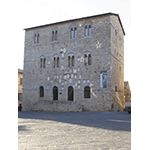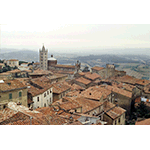Museo Civico Archeologico [Civic Archaeological Museum]
Overlooking one of the loveliest plazas in Italy, the Palazzo del Pretorio has housed the Massa Marittima Archaeological Museum since 1867. The first information on the Palazzo is found, according to the local historian Luigi Petrocchi, in a "contract stipulated in 1231 between the Podestà of the time and a certain Jacobo, a Lombard master marble-worker". The austere palazzo built of travertine, enlivened by mullioned windows and coats of arms, still conserves on its facade the metal bar known as the "step", utilised since 1586 as one of the Commune's standard units of measurement.
Although the Museum's importance is basically historical-archaeological, elements of notable scientific interest are to be found in its collections. On the ground floor, in fact, in addition to a historic collection of archaeological findings, there is a fine group of ceramic materials coming from the local antique pharmacy "Dr. Bernardino Mencacci": in particular, decorated jars, bearing inscriptions of the medicinal substances they contained (Wormwood, Bolus, Senna), along with some sixteenth-century pharmaceutical albarellos (some of the objects will be moved to the new museum of religious art at San Pietro all'Orto).
On the upper floors are archaeological materials coming from the research conducted from 1980 to the present at the nearby Lake of Accesa. Vases, jewellery and utensils for spinning, accompanied by explanatory panels and plastic models, illustrate the daily life of the ancient village.
In addition to learning about Etruscan building techniques, visitors are introduced to the difficult art of weaving in the ancient world, thanks to a loom carefully reconstructed on the basis of archaeological findings and iconographic models. It is a straight loom, made of oakwood, and equipped with the terracotta weights (originals) that served to stretch the threads downward. During an exhibition held in Prato in 1996, the loom's operation was tested by using it to weave a piece of linen cloth, with thread count and weft density similar to that of some fragments of fabric found in Etruscan tombs.
****************************
Texts by Elena Fani
English translation by Catherine Frost
Last update 07/gen/2008





